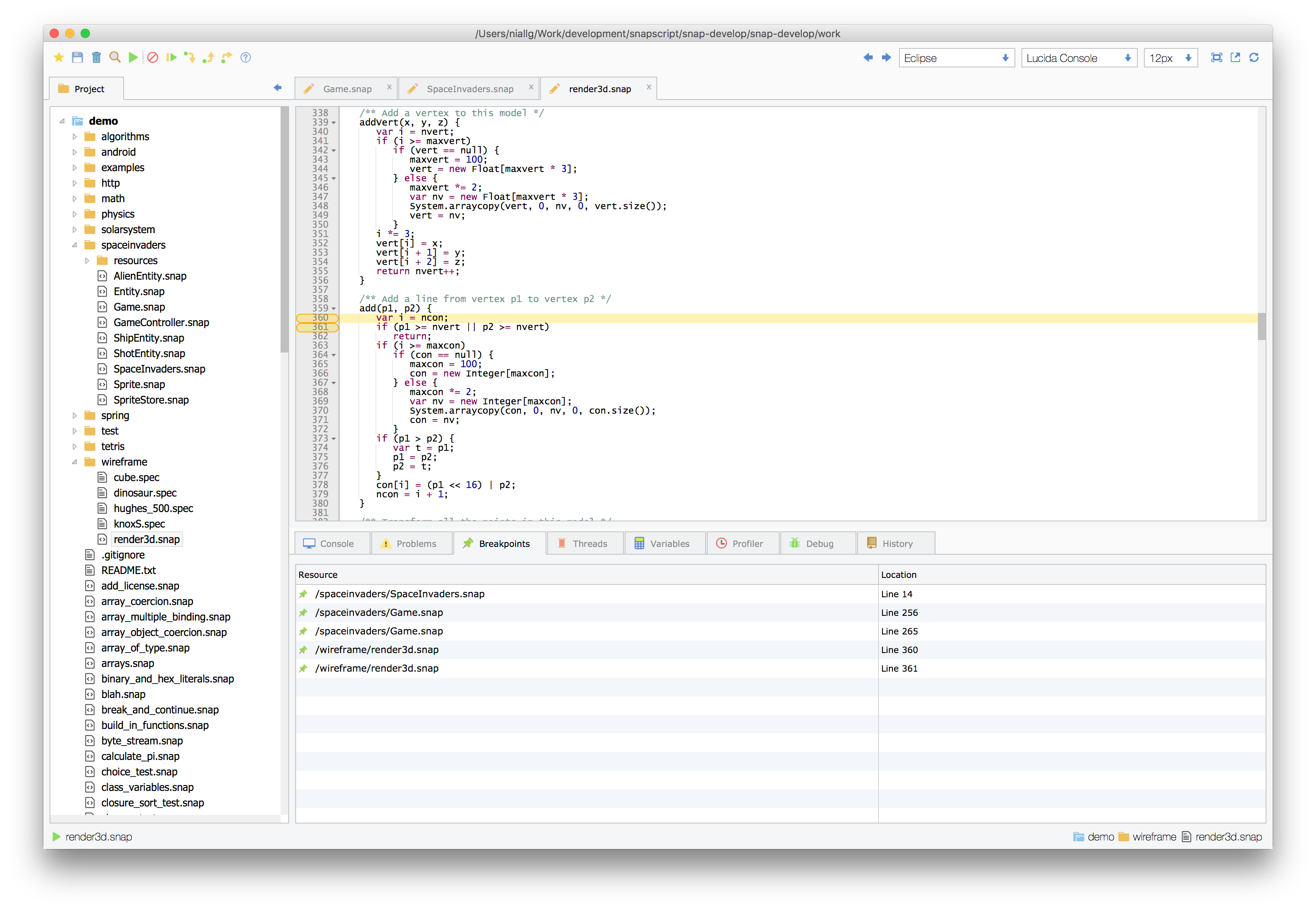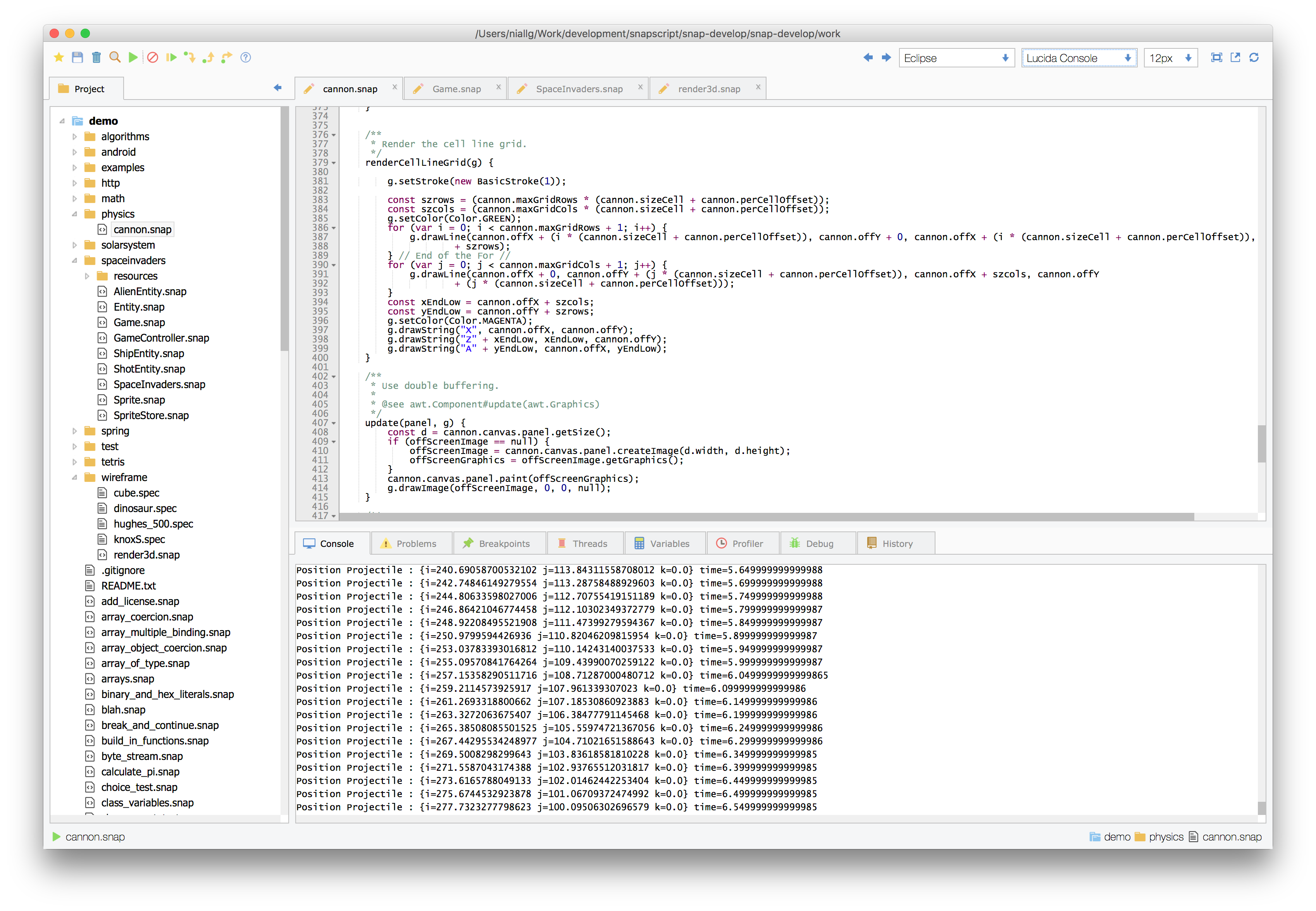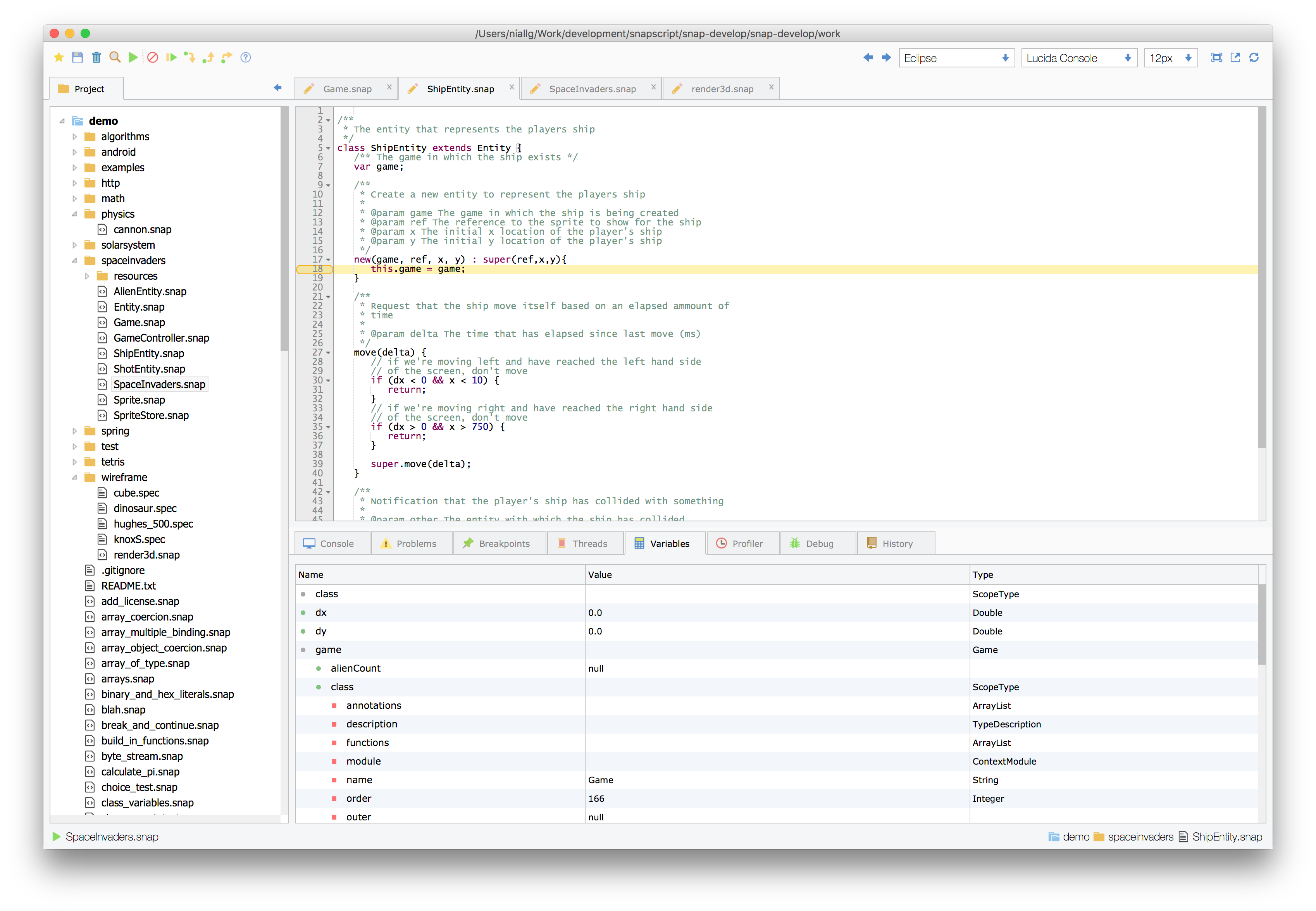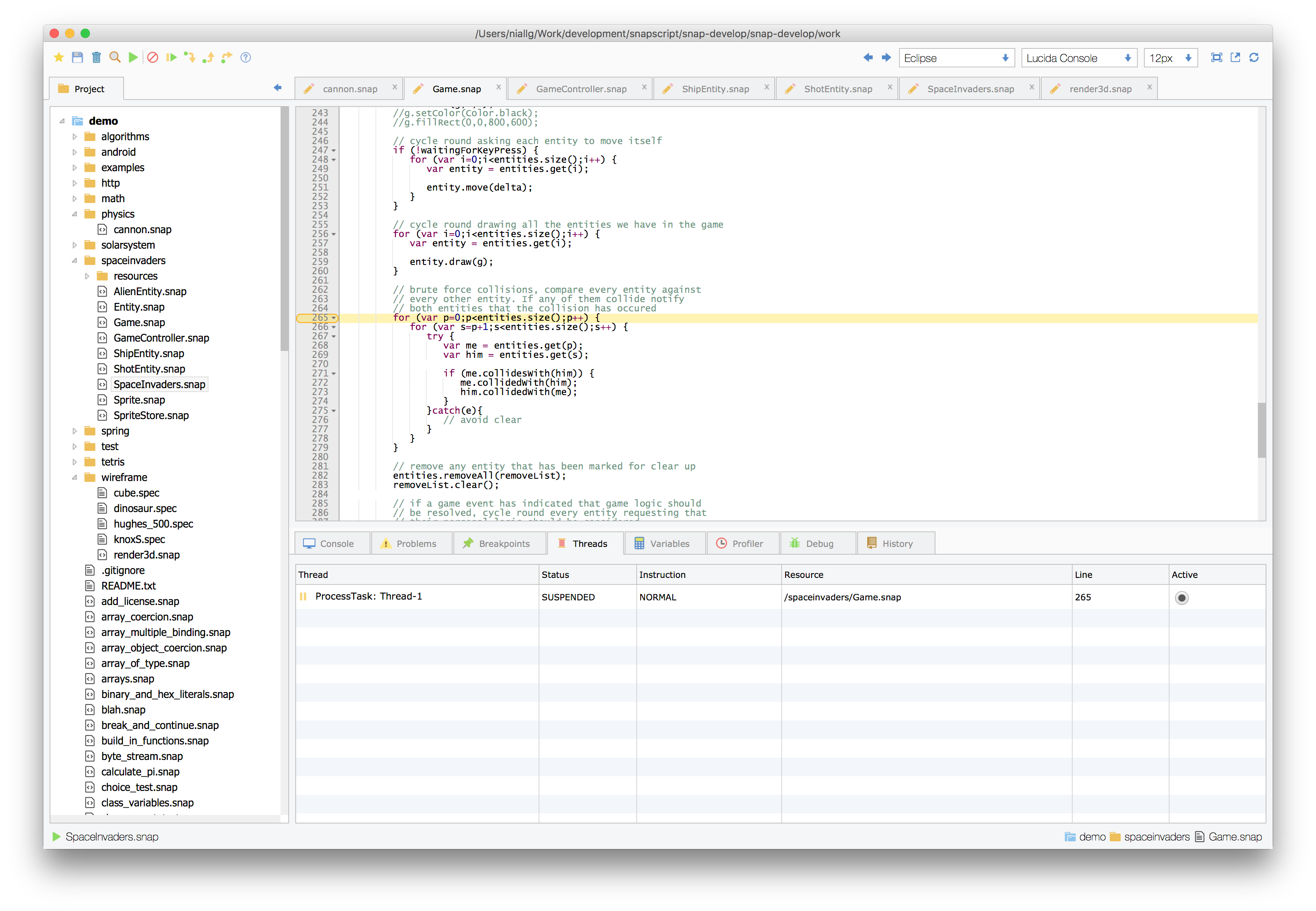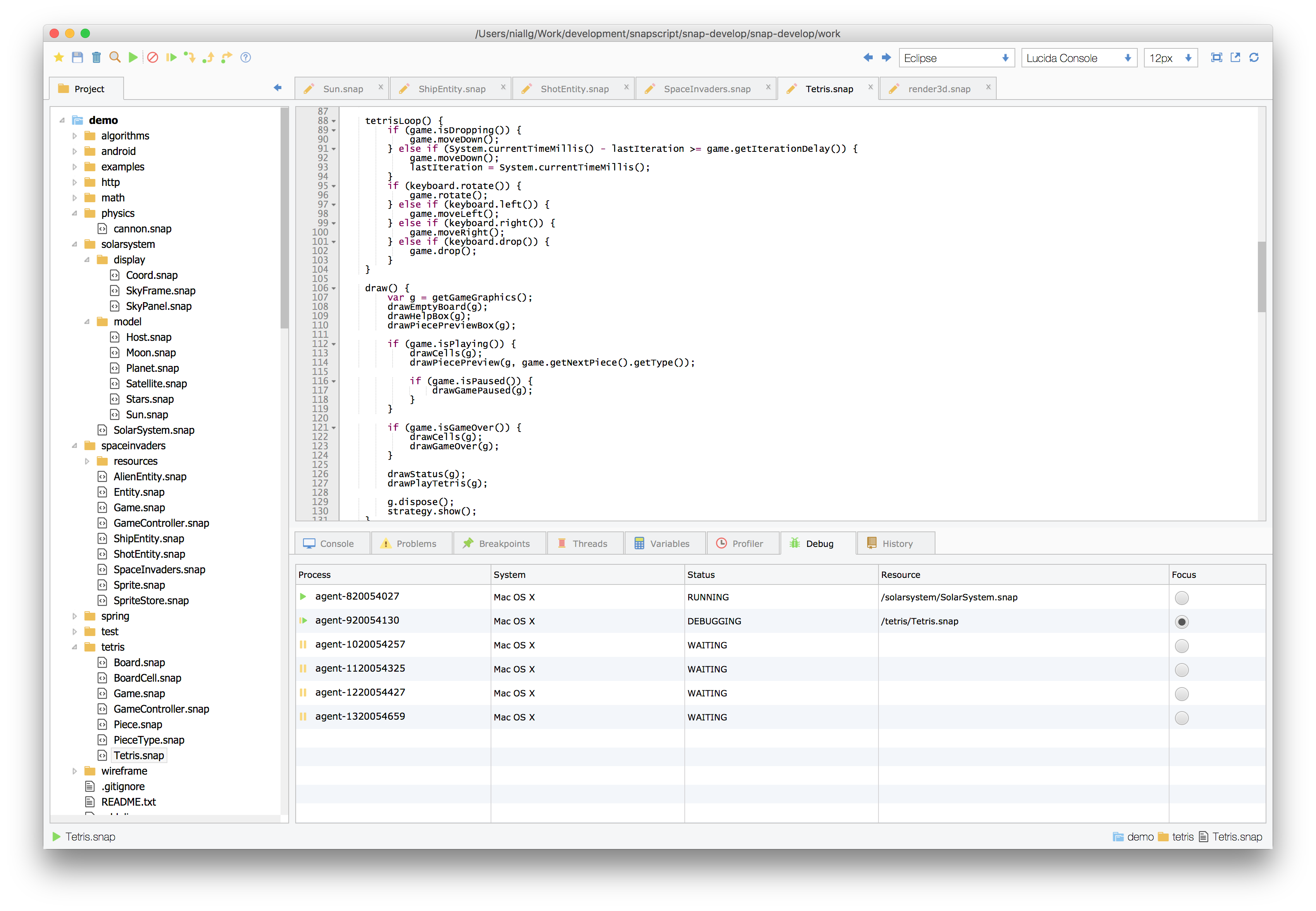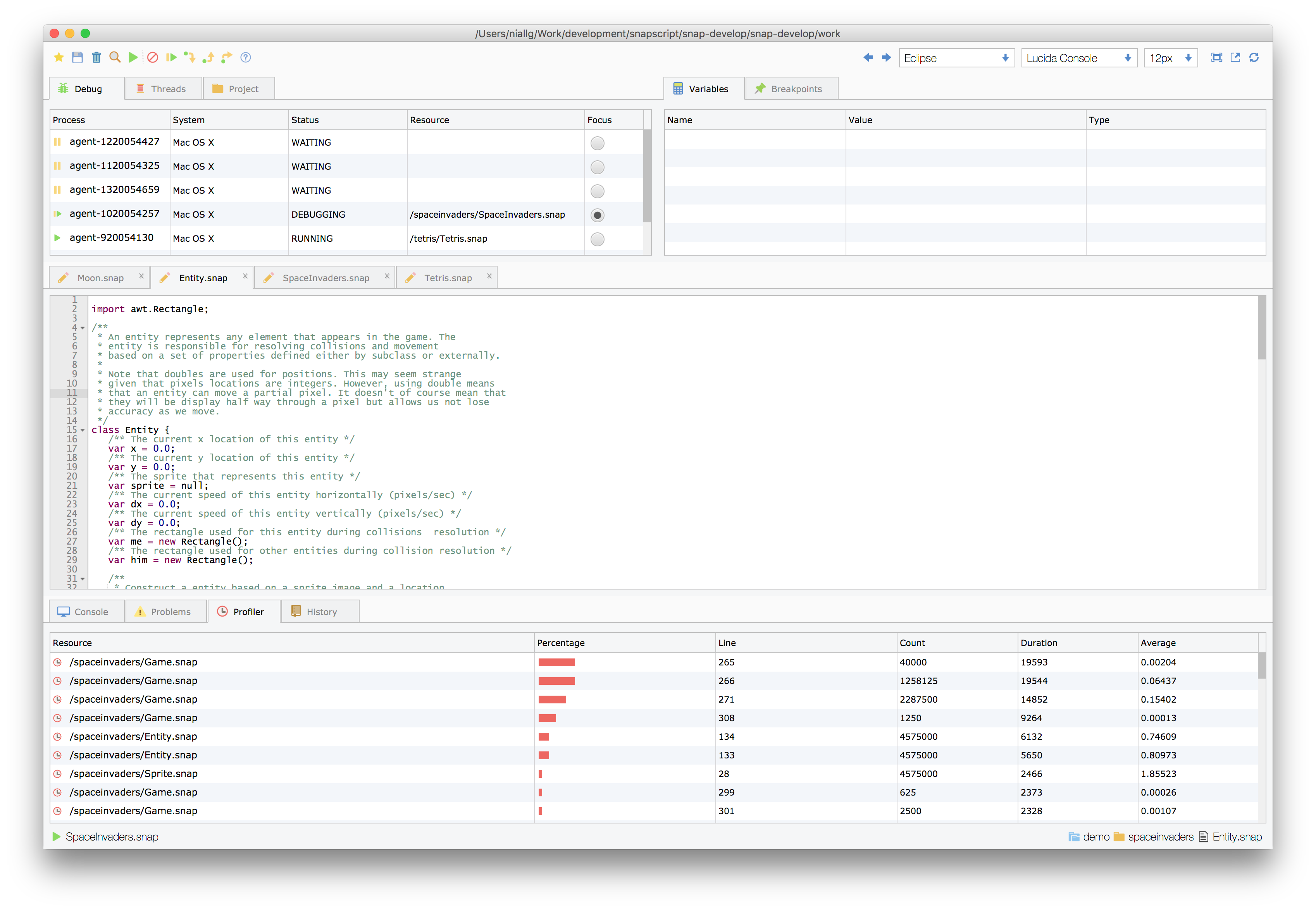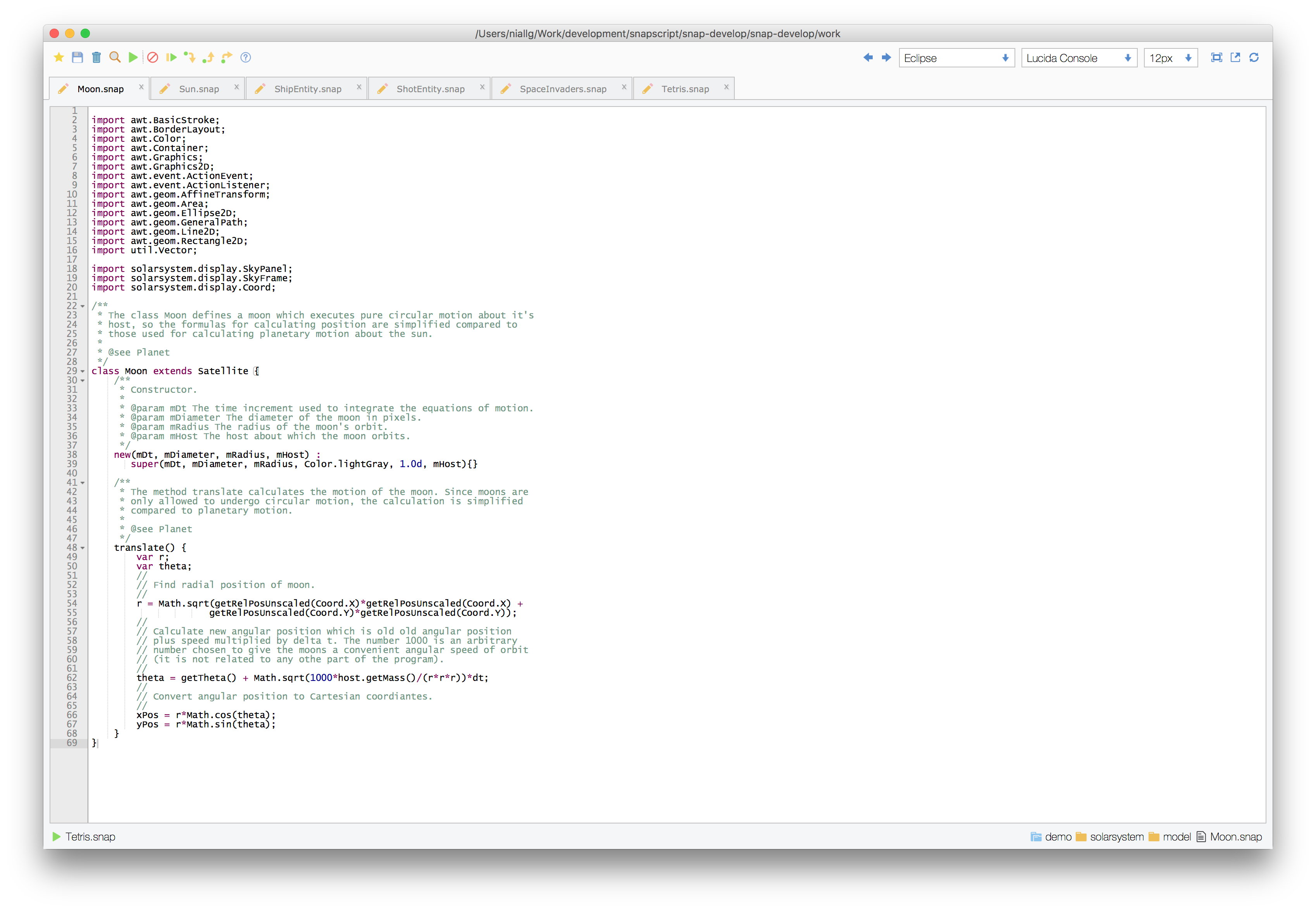Snap is an open source, optionally typed, object oriented scripting language for the Java platform. The learning curve is small for anyone with experience of Java, JavaScript, TypeScript, or Scala, amongst others. It has excellent integration with the host platform, and can do whatever can be done with Java and much more.
Snap is an open source, optionally typed, object oriented scripting language for the Java platform. The learning curve is small for anyone with experience of Java, JavaScript, TypeScript, or Scala, amongst others. It has excellent integration with the host platform, and can do whatever can be done with Java and much more.
The language is ideal for embedding in to an existing application, and is a fraction of the size of similar languages for the Java platform. In addition to embedding it can be run as a standalone interpreter and has an development environment which allows scripts to be debugged and profiled.
Snap programs can be separated in to multiple source files that define the types and functions representing the execution flow. To minimise start times the parsing and assembly of the source is performed in parallel. Once defined the execution graph is joined in to a single executable and static analysis is performed.
The tools and frameworks required to parse and assemble the source code are all custom and written from the ground up with performance and correctness being the primary goals. In most conventional implementations a grammar is used to generate the parser, however for flexibility this implementation processes the grammar at runtime as the program starts, the parser has no prior knowledge of the grammar. This architecture simplifies the implementation and makes the language more extensible.
In the initial phase of compilation the source is passed through a scanner and compressor. This removes comments and command directives from the source text in addition to whitespace that has no semantic value. When the scanner has completed it emits three segments representing the compressed source text, the line numbers the source was scanned from, and a type index classifying the source characters.
To make sense of the source code a custom grammar is required. The grammar used for compilation of the Snap language leverages a custom framework that uses a variant of Bacus Naur Form (BNF). It is defined using special rules and literal values that form the basis of a recursive descendant parser.
| Rule | Semantics |
|---|---|
| | | Represents a logical OR |
| * | Represents one or more |
| + | Represents at least once |
| ? | Represents one or none |
| <> | Define a production |
| () | Group productions and literals |
| {} | Group productions where first match wins |
| _ | Represents whitespace |
| [] | Represents a symbol |
| '' | Represents a literal text value |
The formal grammar for the language is defined with these rules, it can be found with the link below.
The lexical analysis phase indexes the source in to a stream of tokens or lexemes. A token can represent one or more primitive character sequences that are known to the parser. For example a quoted string, a decimal number, or perhaps a known keyword defined in the grammar. To categorise the tokens the formal grammar is indexed in to a sequence of literals. If a token matches a known literal then it is classified as a literal. Any given token can contain a number of separate classifications which enables the parser to determine based on the grammar and its context what the token represents.
When this phase of processing completes there is an ordered sequence of classified tokens. Each token will have the line number it was extracted from in addition to a bitmask describing the classifications it has received. It is up to the parser to map these tokens to the formal grammar.
The parser consumes the sequence of categorised tokens produced by the lexer. The parser has backtracking semantics and is performed in two phases. The first phase is to the map the tokens against the grammar and the second phase is to produce an abstract syntax tree (AST).
The final phase of the compilation process is assembly. This process uses a configured set of instructions to map top level grammars to nodes within an execution graph. Configuring a set of instructions facilitates a dependency injection mechanism which is used to build the program.
The AST is traversed in a depth first manner to determine what the instruction dependencies are needed. As the traversal retreats back up from the leafs of the tree to the root instructions are assembled. This process is similar to how many other dependency injection system works.
As a program grows large so to does its complexity. To manage this complexity static analysis is performed across the entire codebase. The level of static analysis performed is up to the developer as types are optional. Access modifiers are also provided to describe intent and visibility of functions and variables.
When leveraging types further qualification can be given in the form of generics. Generics allow the developer to describe the types of parameters that can be used for a specific declaration.
Code evaluation is the process of transforming text to code at runtime. This can be useful when you want to perform some dynamic task. In languages such as Java the reflection framework allows developers to introspect and execute code in a dynamic way. With evaluation you can achieve similar functionality without the boilerplate. Internally evaluations cache the execution trees they represent which eliminates the performance overheads.
let instance = eval("new " + type + "()");The command directive is used to tell command interpreters where the interpreter for the source is located. This is is often called the 'shebang' directive and is interpreted by common shells like bash. The first line of any Snap source file can contain this command directive.
#!/usr/bin/env snapThe best way to learn any language is through examples. Below is a collection of examples from applications that have been written in Snap. The source code for these examples are available on Github and are free to download.
This is a clone of the Mario Game comes with the full source code in addition to the images and sounds. It has been written twice, once with full static typing and once with dynamic typing. Below is a YouTube video of the program being run and debugged with Snap Studio.
Source Code - Statically Typed
Source Code - Dynamically Typed
This is a clone of the Flappy Bird game and is targeted for Android. Below is a YouTube vide of the application being run and debugged remotely with Snap Studio.
This is a very basic clone of the classic Space Invaders game. The implementation is short but leverages some of the more interesting language features such as async await.
This is a very basic clone of the classic Tetris game. The implementation does not leverage graphics or sounds and shapes are painted on the screen with AWT primitives.
Learning how to code applications with Snap is easy, particularly if you have experience with Java, Javascript, or a similar language. Below you will find various sections illustrating the basics, where you will learn about types, functions, and the various statements and expressions that can be used.
For programs to be useful, we need to be able to work with some of the simplest units of data such as numbers, strings, structures, boolean values, and the like. Support for these basic types is much the same as you would expected for Java, with some additional features such as string templates, map, set, and list literals.
In order to reference values they must be associated with a variable. Variables are declared with the keyword
let or const. A variable can have an optional constraint by declaring a type. If constrained a
variable can only reference values of the declared type.
let v = 22; // v can reference any type
let i: Integer = 22; // i can only reference integers
let d: Double = 22.0; // d can only reference doubles
const c = 1.23; // c is constant, it cannot changeThe most basic type is the simple true or false value, which is called a boolean value.
let a = true; // value a is true
let b = false; // false
let c = Boolean.FALSE; // type constraint of Boolean
let d: Boolean = Boolean.TRUE; // like Boolean d = Boolean.TRUE
let e = Boolean.FALSE; // like Object e = Boolean.FALSEThe most basic type is the simple true or false value, which is called a 'boolean' value.
let binary = 0b0111011; // binary literal
let hex = 0xffe16; // hexidecimal literal
let int = 11;
let real = 2.13;
let typed: Integer = 22; // integer value 22
let coercion: Double = "1.234e2"; // coercion of string to doubleA fundamental part of creating programs is working with textual data. As in other languages, we use the type string to refer to these textual types. Strings are represented by characters between either a single quote or a double quote. When characters are between double quotes they are interpolated, meaning they have expressions evaluated within them. These expressions start with the dollar character. All strings can span multiple lines.
let string = 'Hello World!'; // literal string
let template = "The sum of 1 and 2 is ${1 + 2}"; // interpolated string
let concat = "The sum of 1 and 2 is " + (1 + 2); // concatenationThe most basic type is the simple true or false value, which is called a 'boolean' value.
let array = new String[10]; // array of strings
let bytes = new Byte[11]; // primitive byte[11]
let byte = array[1]; // reference element in array
let matrix = new Long[10][22]; // multidimensional long[10][22];
let long = matrix[2][3]; // reference multidimensionalComplex data structures can be represented with a simple and straight forward syntax. Collection types found in Java such as maps, sets, and lists can be represented as follows.
let set = {1, 2, "x", "y"}; // creates a LinkedHashSet
let list = [1, 2, 3]; // creates an ArrayList
let map = {"a": 1, "b": 2}; // creates a LinkedHashSet
let empty = {:}; // creates an empty map
let mix = [1, 2, {"a": {"a", "b", [55, 66]}}]; // mix collection typesOperators are special symbols that perform specific operations on one, two, or three operands, and then return a result. They are typically used to manipulate or compare values.
Arithmetic operators are used in mathematical expressions in the same way that they are used in algebra.
let a = 10;
let b = 20;
let c = a + b; // add is 30
let d = b - a; // subtract is 10
let e = b / a; // divide is 2
let f = a * b; // multiply is 200
let g = b % a; // modulus is 0
let h = a++; // a is 11 and h is 10
let i = b--// b is 19 and i is 20
let j = --a; // a is 10 and j is 10
let k = ++b; // b is 20 as is kRelational operators are used to make comparisons, such as equal to, not equal to, greater than, less than.
let a = 10;
let b = 20;
let c = a == b // equal operator, c is false
let d = a != b; // not equal operator, d is true
let e = a > b; // greater than operator, e is false
let f = a < b; // less than operator, f is true
let g = a <= b; // g is false
let h = a >= b; // h is trueBitwise operators are used to manipulate numbers, typically integers, at the byte level. They do so by change the binary representation of the value.
let a = 0b00111100;
let b = 0b00001101;
let c = a & b; // bitwise and, c is 00001100
let d = a | b; // bitwise or, d is 00111101
let e = a & b; // bitwise xor, e is 00110001
let f = ~a; // f is 11000011
let g = f >> 2; // f is 00110000
let h = f << 2; // h is 11000000
let i = f >>> 2; // unsigned shift, i is 00110000Logical operators are typically used to combine multiple relational operations in to a single boolean result.
let a = 1;
let b = 3;
let c = true;
let d = false;
let e = a && b; // e is false
let f = a || b; // f is true
let g = !d; // not operator, g is true
let h = b > a && a == 1; // logical and of, h is true
let i = b > a && a != 1; // i is falseConditional statements are used to perform different actions based on different conditions.
The if statement is used to specify a group of statements to execute if a statement is true.
const a = 2;
const b = 3;
if(a < b) { // true
println("a > b"); // prints as a < b
}The else statement is used to specify a group of statements to execute if a statement is false.
const a = 2;
const b = 3;
if(a >= b) { // false
println("a >= b");
} else {
println("a < b"); // prints as a < b
}The unless statement is used to specify a group of statements to execute if a statement is false.
const a = 2;
const b = 3;
unless(a > b) { // false
println("a > b"); // prints as a < b
}The assert statement is used to determine if an expression evaluates to true or false. If the expression evaluates to true the operation has no effect, otherwise an assertion exception is thrown.
const a = 2;
const b = 3;
assert a < b;
assert a > b; // assert exceptionThe debug statement is used to suspend any attached debugger if and expression evaluates to true. This can be useful if there is a specific part of the program that you want to evaluate given a known state of execution. It is similar to the debugger statement for JavaScript with the addition of logic predicate the suspension.
debug a * b > 4; // suspend the debugger if trueTo make statements more concise there is a ternary operator.
let a = 2;
let b = 3;
println(a >= b ? "a >= b" : "a < b"); // prints a < bThe null coalesce operator is similar to the ternary operator with one exception, the evaluation is whether a value is null.
let a = null;
let b = 3;
println(a ?? b); // prints bLoops are used to perform a group of statements a number of times until a condition has been satisfied.
The while statement is the simplest conditional statement. It repeats a group of statements while the condition it evaluates is false.
let n = 0;
while(n < 10) { // conditional loop
n++;
}The for statement is typically used to count over a range of numeric values. It contains three parts, a declaration, a condition, and an optional statement which is evaluated at the end of the loop.
for(let i = 0; i < 10; i++){ // loops from 1 to 10
if(i % 2 == 0) {
continue; // continue loop
}
println(i); // prints only odd numbers
}The for in statement offers a simpler way to iterate over a range of values, a collection, or an array.
let list = [35, 22, 13, 64, 53];
for(e in list){ // iterates over the list
println(e);
}
for(e in 0..9) { // iterates from 0 to 9
if(e == 7) {
break; // exit loop when e is 7
}
println(e); // prints from 0 to 6
}The loop statement offers a way to specify an infinite loop, it does not evaluate any condition.
let n = 0;
loop { // infinite loop
if(n++ > 100) {
break;
}
}Exceptions are used to indicate an error has occurred. It offers a simple means to return control to a calling function, which can then handle the error. Typically an exception object is thrown, however it is possible to throw any type.
In order to catch an exception the throwing statement needs to be wrapped in a try catch statement. This statement basically allows the program to try to execute a statement or group of statements, if during execution an exception is thrown then an error handling block is executed.
try {
throw new IllegalStateException("some error");
} catch(e: IllegalStateException) {
e.printStackTrace();
}The finally statement is a group of statements that are always executed regardless of whether an exception is thrown.
try {
throw "throw a string value";
} catch(e) {
println(e);
} finally {
println("finally always runs");
}Functions group together control structures, operations, and method calls. These functions can then be called when needed, and the code contained within them will be run. This makes it very easy to reuse code without having to repeat it within your script.
The most basic type of function is declared with a name and a specific number of parameters. Such a method can then be called using the declared name by passing in a right number of arguments.
let r = max(11, 3, 67); // r is 67
func max(a, b) {
return a > b ? a : b;
}
func max(a, b, c) { // function overloading
return a < b ? max(a, c) : max(b, c);
}In order to bind invocations to the correct function implementation it can be declared with optional type constraints. These type constraints will ensure that variables of a specific type will be bound to the correct implementation.
let x: Double = 11.2;
let y: Integer = 11;
let z: String = "11";
f(x); // prints double 11.2
f(y); // prints integer 11
f(z); // prints string 11
f(true); // type coercion to string, prints string true
func f(x: Integer) {
println("integer ${x}");
}
func f(x: Double) {
println("double ${x}");
}
func f(x: String) {
println("string ${x}");
}At times it can be useful to provide a large number of arguments to a function. To achieve this the last parameter can be declared with a variable argument modifier.
let result = sum(0, 13, 44, 234, 1, 3);
func sum(offset, numbers...){ // variable arguments
let size = numbers.size();
let sum = 0;
for(let i = offset; i < size; i++){
sum += number;
}
return sum;
}A closure is an anonymous function that captures the current scope and can be assigned to a variable. This variable can then act as a function and can be called in the same manner.
const square = (x) -> x * x;
const cube = (x) -> square(x) * x;
cube(2); // result is 8
const printAll = (values...) -> {
for(var e in values) {
println(e);
}
}
printAll(1, 2, 3, 4); // print all valuesA function handle is simply a way to reference an existing function as a closure. Function handles can represent constructors or functions that are in scope. For example take the constructor for a string, it is quite possible to execute the following.
['a', 'b', 'c'].iterator.forEachRemaining(this::println)Here we are calling the println function with the item passed to the function. This function is represented as a function handle that takes a string. A function handle can represent a static or an instance function. For example:
class Formatter {
public static upper(s: String) {
return s.toUpperCase();
}
}
['a', 'b', 'c'].stream().map(Formatter::upper).forEach(this::println);Generics can be used to qualify the arguments that can be passed to a function. They are useful when the static analyser verifies the program as it ensures arguments and return types match the declared qualifiers.
func abs<T: Number>(nums: T): List<T> {
let result: List<T> = [];
for(num in nums) {
let abs = num.abs();
result.add(abs);
}
return result;
}
let list: List<Double> = abs<Double>(-1.0, 2.0, -3.0);
assert list[0] == 1;
assert list[2] == 2;It is often useful to suspend execution of a function in order to return a result. Typically this requires a great deal of effort from the developer. Coroutines allow an idomatic means of suspending the execution of a function which can be resumed at the point of suspension. This allows for complex reactive iteration to be performed with minimal effort. For example take a Fibonnaci sequence.
func fib(n){
let a = 1;
let b = 2;
until(n-- <= 0) {
yield a;
(a, b) = (b, a + b);
}
}Asynchronous functions can be implemented with the async and await modifiers. This is similar to a standard Coroutine however this paradigm will allow the execution of the program to fork in two different threads of execution.
async loadImage(n: String): Promise<?> {
return await ImageIO.read(n);
}Blank parameters allow you to specify an argument that is not needed or can be ignored.
func create<T>(type: T): T {
return cache.computeIfAbsent(type.name, (_) -> new T());
}In any substantial application types are required. A type is basically a way to define and encapsulate variables and functions within a named scope. All types can have generic parameters allowing the static analyser to verify interactions with the type.
A class is the most basic type. It contains variables and functions that can operate on those variables. Once declared a type can be instantiated by calling a special function called a constructor.
class NumberCache<K, V: Number> {
let map = new HashMap<?, V>();
public cache(k: K, v: V) {
map.put(k, v);
}
public fetch(k: K): V {
return map.get(k);
}
}
let cache = new NumberCache<String, Double>();
cache.cache('1', 1.0);
cache.cache('2', 2.0);An enumeration is a type that specifies a list of constant values. This values are constant and are instances of the enum they are declared in.
enum Color {
RED("#ff0000"),
BLUE("#0000ff"),
GREEN("#00ff00");
let rgb;
new(rgb) {
this.rgb = rgb;
}
}
let red = Color.RED;
let blue = Color.BLUE;A trait is similar to a class in that is specifies a list of functions. However, unlike a class a trait does not declare any variables and does not have a constructor. It can be used to add functions to a class.
trait Format
format(a);
}
class BoldFormat with Format{
override format(a) {
return "<b>${a}</b>";
}
}
class ItalicFormat with Format {
override format(a) {
return "<i>${a}</i>";
}
}A module is collection of types, functions, and variables. It is similar to enclosing a script within a named type. Modules are useful in providing constructs such as singletons.
module ImageStore {
private const cache = {:};
public find(name) {
return cache.get(name);
}
private cache(name, image) {
cache.put(name, image);
}
} It can often be useful to alias types for readability, particularly when generics are involved. An alias is not a new type but rather a new name for a known type.
import util.concurrent.ConcurrentHashMap;
type Bag<T> = ConcurrentHashMap<String, T>();
func bagOf<T: Number>(nums...: T): Bag<T> {
let bag: Bag<T> = new Bag<T>();
for(num in nums){
bag.put(`${num}`, num);
}
return bag;
}In order to access the Java types available they can be imported by name. Once imported the type can be instantiated and used as if it was a script object. In addition to importing types, functions can also be imported by using a static import.
import static lang.Math.*; // import static functions
import security.SecureRandom;
const random = new SecureRandom(); // create a java type
const a = random.nextInt(40);
const b = random.nextInt(40);
const c = max(a, b); // Math.max(a, b)
println(c); // prints the maximum randomTo avoid name collisions it is also possible to import types with aliases. Additionally an imports visibility can be encapsulated within a module so that it is only available in that module.
import util.concurrent.ConcurrentHashMap as Bag;
module ImageStore {
import aws.image.BufferedImage as Image;
import aws.Graphics;
public paint(g: Graphics) {
// ...
}
}For interfaces that have only a single method a closure can be coerced to that interface type. This makes for a much simpler and concise syntax similar to that offered by Java closures.
const set = new TreeSet((a,b)->Double.compare(a,b));
set.add(1.2);
set.add(2.3);
set.add(33.4);
set.add(4.55);
set.add(2);
for(entry in set){
println(entry);
}To leverage the large array of frameworks and services available on the Java platform any Java type can be instantiated, and any Java interface can be implemented.
class DoubleComparator with Comparator{
override compare(a,b){
return Double.compare(a,b);
}
}
let comparator = new DoubleComparator();
let set = new TreeSet(comparator);
set.add(1.2);
set.add(2.3);
set.add(33.4);
set.add(4.55);
set.add(2);
for(let entry in set){
println(entry);
}To be productive in any language there needs to be a way to write, evalute and debug applications. The development environment is free to use and can be used in any standard web browser supporting HTML 5. Alternatively this development client can be run as a standalone application.
The development environment, Snap Studio, is written with HTML5 and TypeScript. It comes packaged as a standalone application leveraging the Chrome embedded framework CEF. Running an application from Snap Studio is as simple has pressing the play button. This will initiate a bootstrapping process where the interpreter is downloaded in to a harness once this boot strapping process has completed the source program is downloaded and executed. Stepping through the code can be done by setting break points.
A breakpoint forces the debugger to suspend at a particular line when execution flow arrives at that line. Once suspended the developer can step in, out or over the statements.
All output from the application is captured in the console and displayed. This console is a scrolling window and will keep only the most recent history up to a configurable number of lines.



